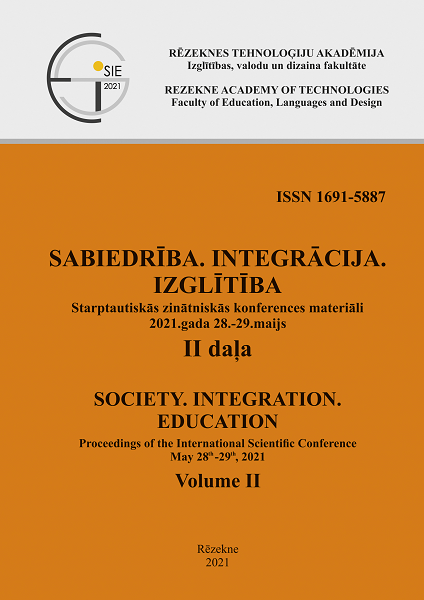THE EFFECTIVENESS OF ZUMBA KIDS IMPLEMENTATION INTO PHYSICAL EDUCATION OF ELEMENTARY SCHOOL PUPILS
DOI:
https://doi.org/10.17770/sie2021vol2.6187Keywords:
elementary school pupils, physical education, Zumba kidsAbstract
The demand to improve physical education process of elementary school pupils by the tools of innovative dancing fitness branch – Zumba Kids is described in the article. Positive changes in dynamics among children have occurred in indicators of functional and physical preparation in conditions of the experiment. The goal of the work is the optimization process of physical education of elementary school pupils by Zumba Kids tools. There were investigated children’s physical development, functional and physical preparation and experimentally was checked the effectiveness of the implementation program of Zumba Kids tolls into process of physical education. There were 54 participants, 26 among them are boys and 28 are girls (the children’s age is 9 years old). The methods of the research are theoretical analysis and literature sources generalization; physiological research methods; pedagogical observation (passing of control standards); pedagogical experiment and mathematical statistics methods. There are presented and scientifically justified the program of implementing Zumba Kids tools into physical education lessons of elementary school pupils. The content of the program consists of the synthesis of energetic modern dances with aerobics, fitness exercises, stretching and also exercises for breathing exercises and muscle relaxation. The elaborated program is realized in the educational process and proved its effectiveness. The results of investigation have shown its positive influence on the functional and physical preparation of elementary school pupils. It was proved by mathematical statistics methods.
Downloads
References
Beliak, Y., Grybovska, I. & Muzyka, F. (2018). The theoretical-mathematical basis of the healing fitness. Lviv: LDUFK.
Bodnar, I., Petryshyn, Y., Solovey, A., & Rymar, O. (2016). Health complaints and well-being complaints among secondary school children. Journal of physical education and sport, 16(3), 905–909.
Bodnar, I., Rymar, O., Solovey, A., & Datskiv, P. (2015). Objective criteria for determination of functional-reserve opportunities of average school age pupils. Pedagogics, psychology and medical-biological problems of the physical education, 11, 11–19.
Bodnarchuk, O., Rymar, O., & Solovey, A. (2018). Interaction of school and family in physical education of first grade pupils. Journal of physical education and sport, 18(2), 1092 – 1098.
Bulatova, M., & Usachov, U. (2008). The modern physical-healing technologies in the physical education. The theory and methodic of physical education, 2, 320–353.
Butenko, H., Goncharova, N., & Saienko, V. (2017). Physical condition of primary school children in school year dynamics Department of Theory and Method Published. Journal of Physical Education and Sport, 2, 543–549.
Chuprun, N.F. (2018). Place Zumba in the physical education of student youth. The journal of CHernigiv national pedagogical university. Series: Pedagogical sciences. Physical education and sport, 154(1), 193–196. Retrieved from http://nbuv.gov.ua/UJRN/VchdpuPN_2018_154(1)__44.
Domene, P., Moir, H., Pummell, E., & Easton, Ch. (2016). Salsa dance and Zumba Fitness: Acute responses during community – based classes. Journal of Sport and Health Science, 190–196.
Hawley, E., & Franks, B. (2000). Health-Related Aerobics. Кyiv.
Khouli, E., & Frenke, B. (2004). The instructor guide of healing fitness. Kyiv: Olympic literature.
Krutsevych, T., & Bezverhniya, G. (2010). Recreation in the physical education of different society groups. Kyiv: Olympic literature.
Moskalenko, N. V. (2018). Construction of rational regimes in motor activity of children aged 3-4 years in pre-school educational institutions of various types. Pedagogics, psychology, medical-biological problems of physical training and sports, 5, 265–271. – http://orcid.org/0000-0001-9162-5206 .
Moskalenko, N.V. (2009). The theoretical-methodical basis of innovative technologies in the system of physical education of elementary school children (“Physical culture, physical education of different society groups”): autoref. diss. Of the doctor of science of physical education and sport. Kyiv.
Pangelova, N. (2017). The modern approaches to organizing physical culture and health related work with lower grades pupils of a comprehensive rural school. Theory and methods of physical education and sports, 3, 93–97. Retrieved from http://nbuv.gov.ua/UJRN/TMFVS_2017_3_16.
Perez, B., Robinson, P., & Herlong, K. (2011). The guide for instructor of fitness program “Zumba”. Florida, USA.
Sarkauskiene, A., Noble, B., & Kardeliene, L. (2019). Non – formal physical education influence on health related physical fitness of children. Society. Integration. Education. Proceedings of the International Scientific Conference, IV, 252–267.
Sorokolit, N., Shyan, O., Lukjanchenko, M., & Turchyk, I. (2017). Improvement of 5-9th Grades Schoolchildren Physical Education in Ukraine by Using Variable Modules Curriculum. Journal of Physical Education and Sport, 17(4), 2110–2115.
Starchenko, A.U. (2014). The children fitness as one of the effective tools of health healing and physical education of pre-school age children. Pedagogical sciences: theory, history, innovative technologies, 2(36), 177–184.
Weinberg, R., & Gould, D. (2003). Foundations of sport & exercise psychology: third edition. Human Kinetics.
Zhdanova, O., Chekhovska, L., & Bakhovskiy, L. (2016). New tendencies of the fitness development. The material from the X All-Ukrainian Scientific-practical conference with international participation “The problems of activation of recreational-healing activity of society”. Lviv, 204–212.


